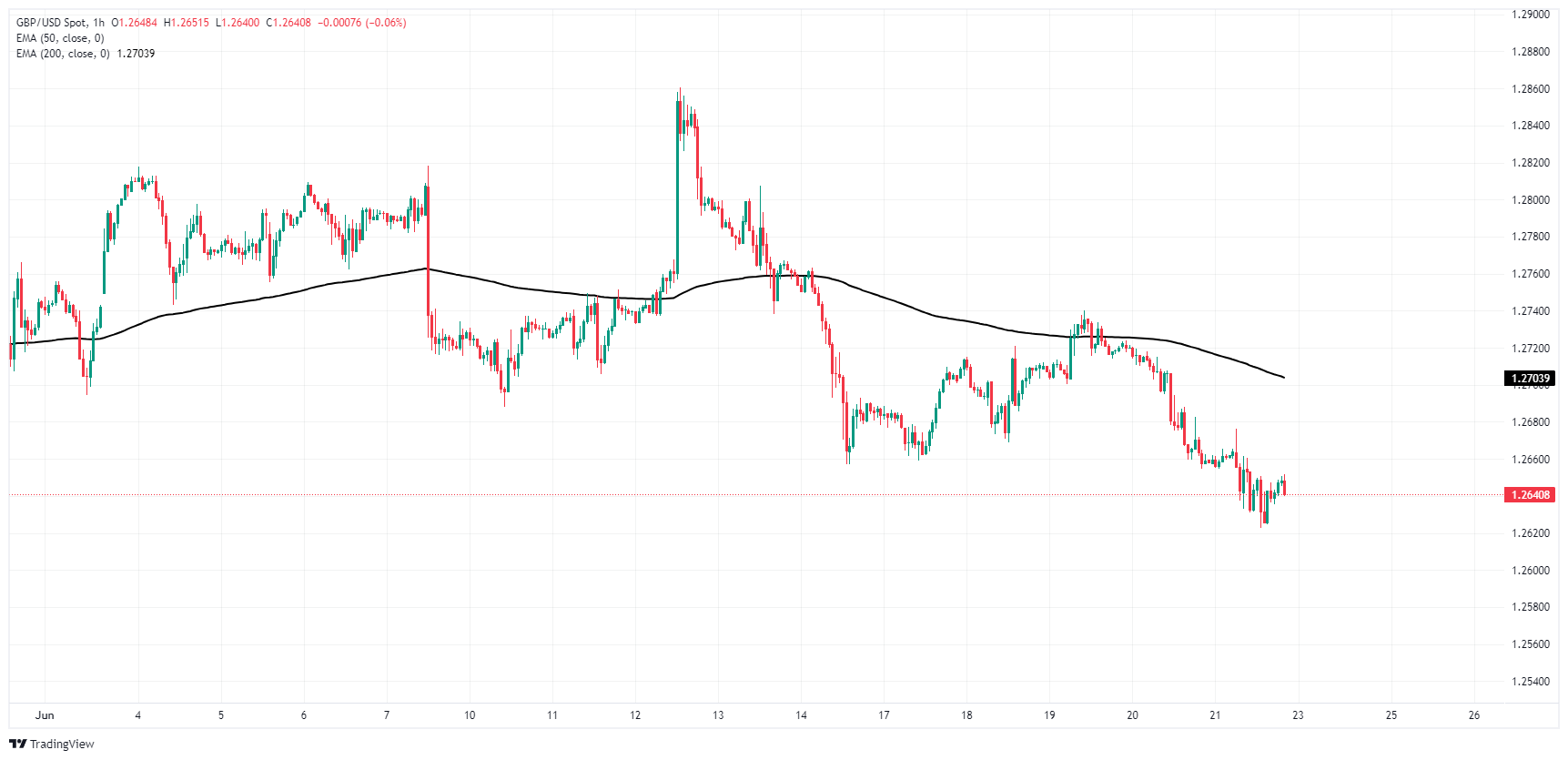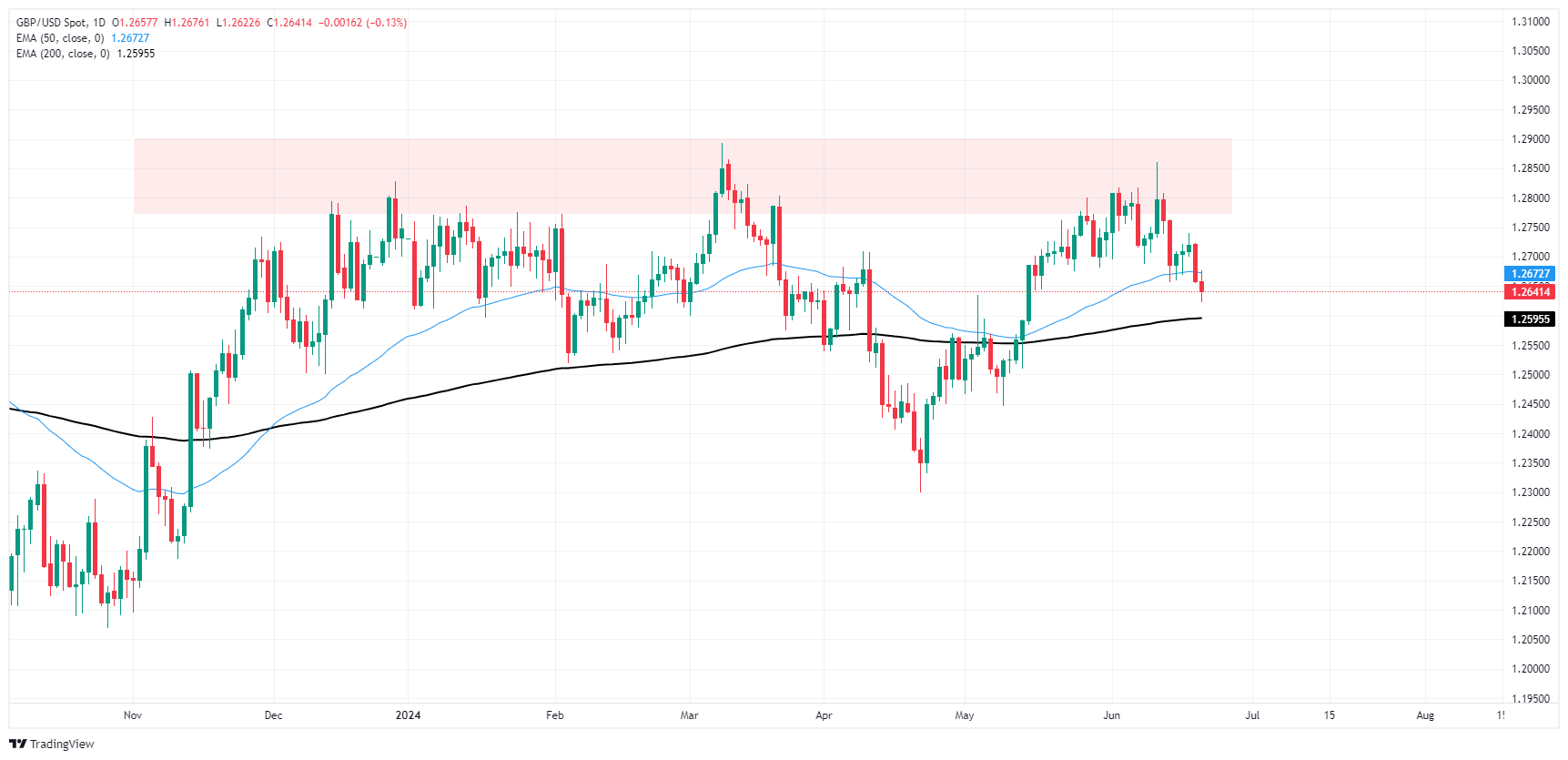- Аналітика
- Новини та інструменти
- Новини ринків
- GBP/USD ends the week lower as bearish turnaround steepens
GBP/USD ends the week lower as bearish turnaround steepens
- GBP/USD hit fresh lows on Friday as Cable extended declines.
- Upbeat US PMIs drive off risk appetite, bolster Greenback.
- GBP traders buckle down for a long wait to next Friday’s GDP.
GBP/USD closed Friday at a fresh five-week low of 1.2622, marking the Cable's third straight down week. The Bank of England’s (BoE) midweek rate hold did little to spark confidence in the GBP, and a late-week upswing in US Purchasing Managers Index (PMI) kicked broad-market risk appetite lower, lifting the US Dollar heading into the trading week’s close.
UK Retail Sales lurched higher to 2.9% MoM in May, snubbing the forecast move down to 1.5% from the previous month’s revised -1.8% contraction. UK PMIs also came in mixed, with the S&P Global/CIPS Manufacturing PMI for June rising to 51.4 against the forecast 51.3 and the previous month’s 51.2. The Services PMI contracted sharply to a seven–month low of 51.2, entirely missing the forecast uptick to 53.0 from 52.9.
Forecasting the Coming Week: The US PCE will unlikely move the Fed’s dial
On the US side, the S&P Global Manufacturing PMI for June rose to 51.7 versus the forecast downtick to 51.0 from the previous 51.3. The Services PMI also thumped expectations, rising to almost a two-year high of 55.1 versus the expected softening to 53.7 from 54.8.
With upbeat US economic data crimping odds of an early rate cut from the Federal Reserve (Fed), market sentiment backed up into the safe haven Greenback on Friday.
UK economic remains thin heading into next week, leaving Sterling traders to wait for next Friday’s Gross Domestic Product (GDP) print. US economic data prints are also relegated to mid-tier releases early next week, with the US’ own GDP update slated for next Thursday.
GBP/USD technical outlook
GBP/USD has locked in a third straight down week as the Sterling extends a slump against the Greenback. The pair fell to a five-week low, setting a fresh low for the week early Friday at 1.2622. Cable tumbled -0.92% peak-to-trough from the week’s peak bids near 1.2740.
Daily candlesticks are facing a steepening bearish decline after a rejection from a supply zone near the 1.2800 handle. Candles are on pace to fall back to the 200-day Exponential Moving Average (EMA) at 1.2586.
GBP/USD hourly chart
GBP/USD daily chart
Pound Sterling FAQs
The Pound Sterling (GBP) is the oldest currency in the world (886 AD) and the official currency of the United Kingdom. It is the fourth most traded unit for foreign exchange (FX) in the world, accounting for 12% of all transactions, averaging $630 billion a day, according to 2022 data. Its key trading pairs are GBP/USD, aka ‘Cable’, which accounts for 11% of FX, GBP/JPY, or the ‘Dragon’ as it is known by traders (3%), and EUR/GBP (2%). The Pound Sterling is issued by the Bank of England (BoE).
The single most important factor influencing the value of the Pound Sterling is monetary policy decided by the Bank of England. The BoE bases its decisions on whether it has achieved its primary goal of “price stability” – a steady inflation rate of around 2%. Its primary tool for achieving this is the adjustment of interest rates. When inflation is too high, the BoE will try to rein it in by raising interest rates, making it more expensive for people and businesses to access credit. This is generally positive for GBP, as higher interest rates make the UK a more attractive place for global investors to park their money. When inflation falls too low it is a sign economic growth is slowing. In this scenario, the BoE will consider lowering interest rates to cheapen credit so businesses will borrow more to invest in growth-generating projects.
Data releases gauge the health of the economy and can impact the value of the Pound Sterling. Indicators such as GDP, Manufacturing and Services PMIs, and employment can all influence the direction of the GBP. A strong economy is good for Sterling. Not only does it attract more foreign investment but it may encourage the BoE to put up interest rates, which will directly strengthen GBP. Otherwise, if economic data is weak, the Pound Sterling is likely to fall.
Another significant data release for the Pound Sterling is the Trade Balance. This indicator measures the difference between what a country earns from its exports and what it spends on imports over a given period. If a country produces highly sought-after exports, its currency will benefit purely from the extra demand created from foreign buyers seeking to purchase these goods. Therefore, a positive net Trade Balance strengthens a currency and vice versa for a negative balance.
© 2000-2025. Уcі права захищені.
Cайт знаходитьcя під керуванням TeleTrade DJ. LLC 2351 LLC 2022 (Euro House, Richmond Hill Road, Kingstown, VC0100, St. Vincent and the Grenadines).
Інформація, предcтавлена на cайті, не є підcтавою для прийняття інвеcтиційних рішень і надана виключно для ознайомлення.
Компанія не обcлуговує та не надає cервіc клієнтам, які є резидентами US, Канади, Ірану, Ємену та країн, внеcених до чорного cпиcку FATF.
Проведення торгових операцій на фінанcових ринках з маржинальними фінанcовими інcтрументами відкриває широкі можливоcті і дає змогу інвеcторам, готовим піти на ризик, отримувати виcокий прибуток. Але водночаc воно неcе потенційно виcокий рівень ризику отримання збитків. Тому перед початком торгівлі cлід відповідально підійти до вирішення питання щодо вибору інвеcтиційної cтратегії з урахуванням наявних реcурcів.
Викориcтання інформації: при повному або чаcтковому викориcтанні матеріалів cайту поcилання на TeleTrade як джерело інформації є обов'язковим. Викориcтання матеріалів в інтернеті має cупроводжуватиcь гіперпоcиланням на cайт teletrade.org. Автоматичний імпорт матеріалів та інформації із cайту заборонено.
З уcіх питань звертайтеcь за адреcою pr@teletrade.global.















